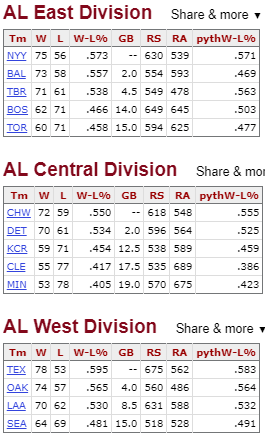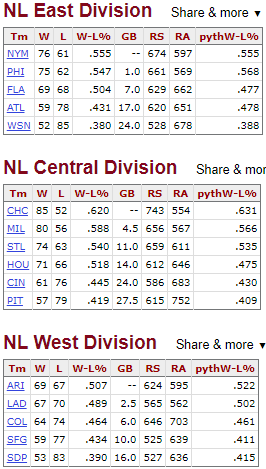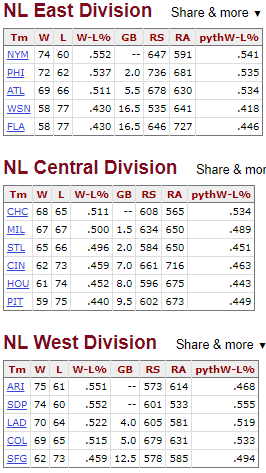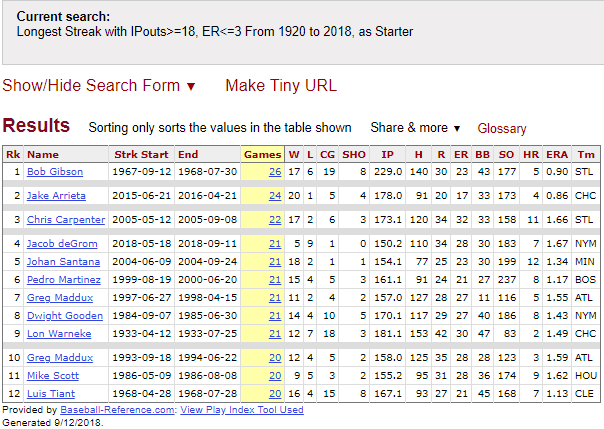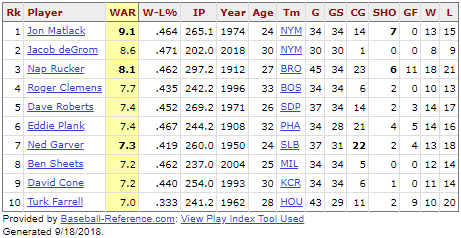This month began with all three NL races hotly contested, as no division leader held more than a 3½ game lead, with 8 of the 15 teams within 4 games in their division and two more within 7½ games. With two wildcard spots up for grabs, there should be many twists and turns before the five post-season berths are finally determined on or about September 30th.
This post takes a look back at some similar Septembers since the three division league alignment was introduced in 1994. Specifically, I’ll be looking at seasons when a league’s three division leaders all had no more than a 5 game lead as September play began. More after the jump.
2012 AL
This was the first season with two wild-card spots, so stakes were even higher as only division winners were assured a spot in the best-of-five LDS, with the last LDS spot going to the winner of a one-game crap shoot between the two wildcard qualifiers.
In the East, the Yankees were looking for redemption after being ousted by the Tigers in the previous year’s LDS, despite outscoring Detroit 28-17 in the series. The Tigers had the same aspirations after bowing out to the Rangers in a 2011 ALCS decided by a pair of extra-inning wins by Texas. The two-time defending AL champion Rangers completed the redemption seekers after an epic 2011 World Series that saw Texas twice come within a strike of a series win before falling to the Cardinals in 7 games.
The Yankees managed to hold onto at least a share of the division lead for the rest of the season, though that lead was never more than 3 games, and the Bombers were tied with Baltimore as late as Sep 30 with just three games to play. New York clinched the division on the last day of the season with a win over Boston and an Oriole loss to the Rays, but the game before held plenty of drama as Baltimore moved to within half a game of the lead after a 1-0 win (finishing the year 29-9 in one-run games), pending the result of the Red Sox-Yankees game that turned in New York’s favor after Raul Ibanez crushed a 9th inning pinch-HR to tie the game and then delivered a walk-off RBI single in the 12th to preserve the Yankees’ slender division lead.
Chicago and Detroit met 5 times early in the month with the Tigers taking four of those games to pull within a game of the White Sox. That lead was stretched out to three games after the Sox ran off five straight W’s, but Chicago’s offense went dry after that, scoring 3 runs or less in 10 of their last 15 games in a 4-11 finish that gave the division title to Detroit (who benefited from a favorable schedule, finishing 9-4 with all of those games against the also-ran Twins and Royals).
Texas looked like winners for most of the month, holding a 4 game lead on Sep 27 after splitting four against the pursuing A’s. But, that lead had been cut in half by the time the two contenders met in a rematch in Oakland to close out the season. The first two were tight, low-scoring affairs won by the A’s as their bullpen preserved slender late inning leads to move into a tie with Texas. The final game, though, was a blowout as Oakland dethroned the defending champs to claim the division title. The Rangers had to settle for a spot in the wildcard game, which they lost to the Orioles.
2008 NL
The East featured a chase between the division champions of the two previous seasons. In the Central the Cubs were trying to make it back to the post-season after getting swept in the LDS the year before, while the Brewers were looking for their first post-season appearance in more than a quarter century, since falling to the Cardinals in the 1982 WS. In the West, the Dodgers were looking to win a post-season series for the first time since their WS win twenty years before, while the D-Backs and Rockies were looking to return to the post-season after both were swept out of the tournament the year before, the Snakes in the NLCS and Colorado in the WS.
The Phillies and Mets met just once in September, with Philadelphia taking two of three early in the month. New York had built up a 3½ game lead by September 10th, but a 7-10 finish was no match for the hard-charging Phils who closed the season 13-3 (with 13 of those 16 games against the division’s also-ran teams in Atlanta, Miami and Washington).
The Cubs and Brewers were scheduled to meet twice during the last two weeks of the season, but the division race was already decided before then, as the Brewers collapsed over the first half of the month with a 3-11 record that saw them fall 8 games behind the front-running Cubbies. Milwaukee righted the ship somewhat after that, finishing 7-5 to secure the wildcard berth by one game over the faltering Mets.
Out west, the defending champion Rox fell out of contention early, dropping seven straight to stand 10½ games back on Sep 15th. The D-Backs were swept in LA early in the month to drop out of the division lead, but Arizona hung tough after that, getting within two games after beating the Cards on Sep 22. But, losses to the Redbirds in the next three games gave the division title to the Dodgers, whose 10-1 run to start the month ultimately proved to be the difference in the race.
2007 NL
There were no dominant teams in the NL this season, with no team more than 14 games over .500 as September play began. Three teams were in contention in the East, four in the West and all six in the Central held some hope as even the bottom-dwelling Pirates were still within 10 games of the lead. The front-running Mets and Padres were looking to defend their division titles of the year before, while the defending league champion Cardinals stood just two games back in the Central.
The Mets, division leaders since May 16th, extended their lead to four games by sweeping the Braves to start the month, and then to 7 games on Sep 12 after taking two of three from Atlanta. The Phillies swept the Mets to get within 3½ on Sep 16, but were only a game closer nine days later with just six left to play. Philadelphia completed the comeback with a 4-2 finish while New York stumbled to 1-6, including dropping three at home to the lowly Nats (and allowing 32 runs in the process).
The turtle derby that was the NL Central race saw the Cubs and Brewers tied on Sep 6 with the Cards just a game back. But, after St. Louis dropped nine in a row, it was a two-team race the rest of the way. After again pulling even with Chicago on Sep 18, the Brewers dropped three of four to the Braves while the Cubs swept the Pirates, giving Chicago a 3½ game lead on Sep 23 that Milwaukee couldn’t overcome (the schedule makers didn’t help the Brewers as they did not face the Cubs at all in September).
The four team race in the West turned into a three team hunt after the Rockies dropped 6½ back on Sep 15, and then a two team chase after the Dodgers dropped 7 in a row to fall 9 back on Sep 22. But, it was back to a three team race after Colorado reeled off 11 straight wins to stand two back of the D-Backs on Sep 27 with the Padres just a game out. Arizona and Colorado closed the season against each other while San Diego faced the Brewers. The D-Backs and Padres won the first games of their series (knocking the Rox out of the division hunt), then remained in lock step as both dropped the next two to clinch the division title for Arizona and leave the Padres and Rockies tied for second (a tie that was broken when Colorado won game 163 to claim the wildcard berth and ultimately the league championship).
2001 NL
The Braves, league champions two years before, were looking to come back from being swept by the Cards in the previous season’s LDS, while the Phillies were still looking for their first post-season appearance since falling to the Blue Jays in the 1993 WS. The Astros, division champions for three years running to close out the ’90s were looking to make it back to the post-season after a sub-par 2000 campaign, while St. Louis was looking for a return to the post-season after their NLCS appearance the year before, and the Cubs were looking for their first post-season series win in more than 90 years. The surprising D-Backs, in only their fourth season, were contending for a second time after taking the division crown two years earlier, while the Dodgers and Giants were both looking to win their first post-season series since their WS appearances in 1988 and 1989.
After leading the East division for most of the first half of the season, the Phillies were swept by the Braves late in June to fall a half game back. Since then, neither team had fallen more than three games behind the other. The Phillies took three of four from the Braves to close within 1½ games on Sep 20, and were two games back when the two teams met again starting on Oct 2. Randy Wolf beat Greg Maddux in the opener to draw Philadelphia within one, but Atlanta won the next two to pull three games ahead with three to play, clinching the division crown the next night with a 20-3 win over Florida.
The Cubs had been leading the Central for the most of the first half of the season, and still held the division lead as late as Aug 17, before slipping back in the wake of the Astros’ 12-2 run to close out that month. The Astros stayed hot, starting September 11-5, while a 4-10 slide by Chicago left them 9 back on Sep 25 and out of contention for good. Houston looked to be in good shape after winning 7 of 8 to stand 5½ games up with twelve to play. But, it was the Cardinals who then won 7 of 8 to move a game ahead of Houston as the two teams met to close out the season in St. Louis. In the opener, Houston rallied with runs in the 8th and 9th to win 2-1 and move back into a tie. But, St. Louis moved ahead again with a comeback win in game two, as closer Steve Kline collected a 6 out save. The Astros prevailed in the finale as the two teams finished the season in a tie, with Houston awarded the division title on the strength of winning the season series between the clubs, and St. Louis taking the wildcard berth.
The three team race in the West tightened up in the first week of September as the front-running D-Backs dropped two of three to the Giants to leave the three contenders all within 1½ games on Sep 7. But the Dodgers then dropped 5 of the next 6 to fall three games back, and would get no closer the rest of the way. The Giants stayed in it but could never pull even with Arizona (whom they didn’t play the rest of the way), before finally get knocked out after dropping a wild game 160 to LA by the score of 11-10 (the Giants came back from 5-0 down to tie the game 10-10),
1997 NL
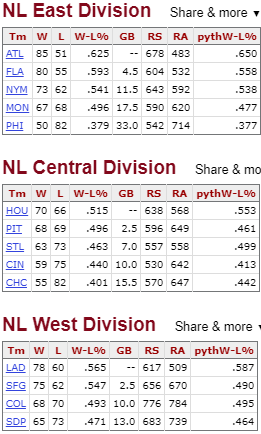
The two-time defending NL champion Braves were looking for the three-peat, while the upstart Marlins, playing in just their fifth season, were contending for the first time. Houston had come close the year before, and were looking to make their first post-season appearance in 11 years. St. Louis were the defending Central champs, while Pittsburgh was contending for the first time since starting the decade with three straight East division titles. The Dodgers had taken the wildcard berth the year before while the Giants were making a huge turnaround from a 94 loss season in 1996.
The Marlins started the month by sweeping the Orioles while Atlanta dropped two of three to Detroit, and the Braves’ lead closed to 2½ games. But, Florida then lost 6 of 7 while Atlanta won 5 of 6, and the Braves were never threatened after that, cruising to the division title on the strength of a 10-4 finish, while Florida took the wildcard spot and ultimately the world championship.
The Astros (5-8) and Pirates (4-9) hit the skids as September began, giving hope to the Reds (10-5) who pulled within 6 games on Sep 15. But, Houston righted the ship to finish 9-4 and were never headed the rest of the way.
Out west, the Dodgers and Giants stayed on each other’s heels right to the end of the season, with no more than 2½ games ever separating the teams. The race would have been even more compelling had the two teams faced each other more than their brief two game set in the middle of the month, won by the Giants to pull even with LA. The Dodgers then dropped three straight at home to the Rockies to fall two games back, and were never able to make up the ground.

